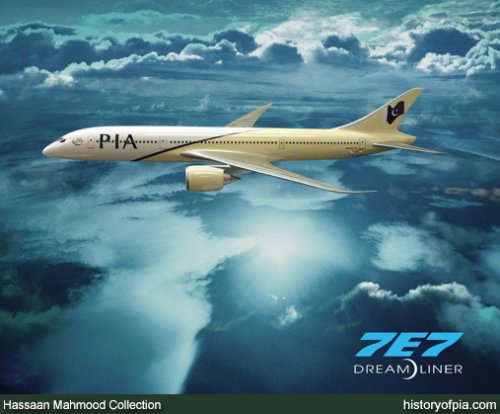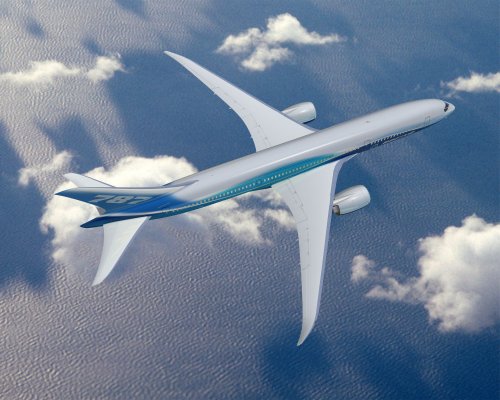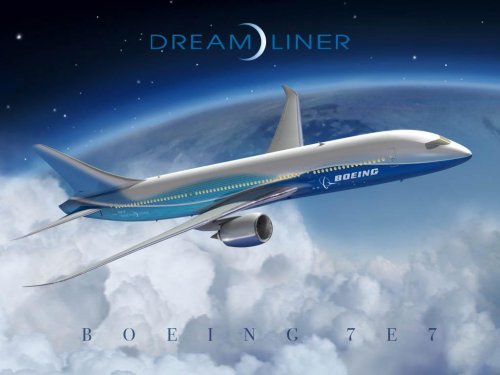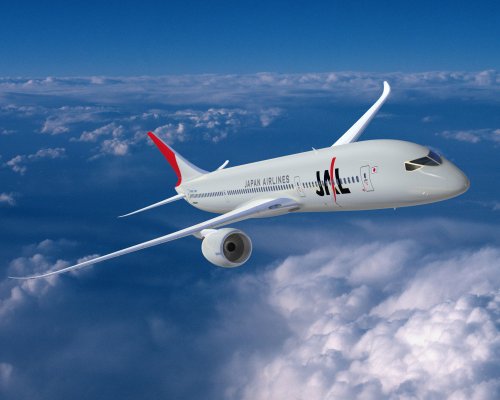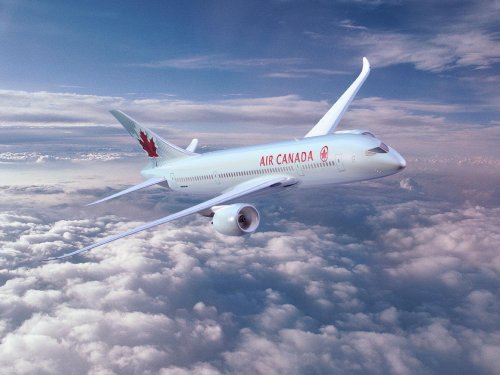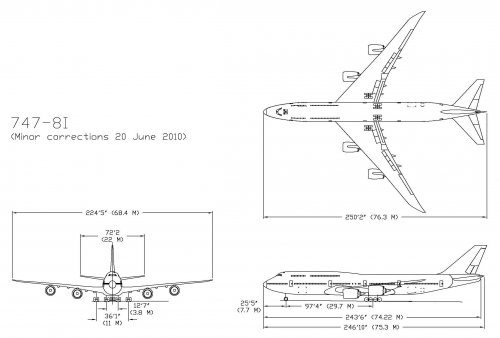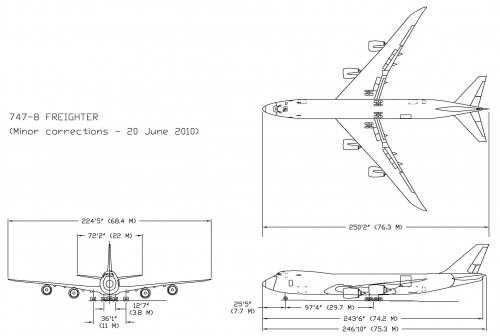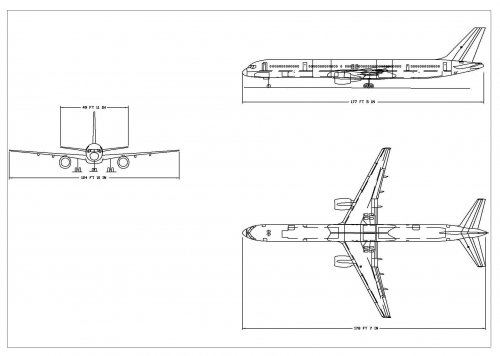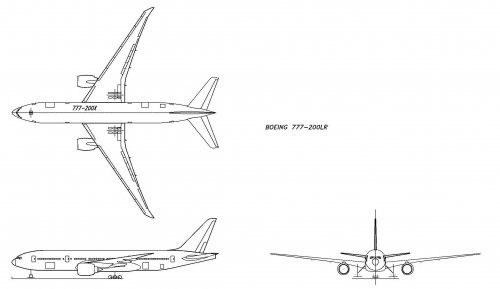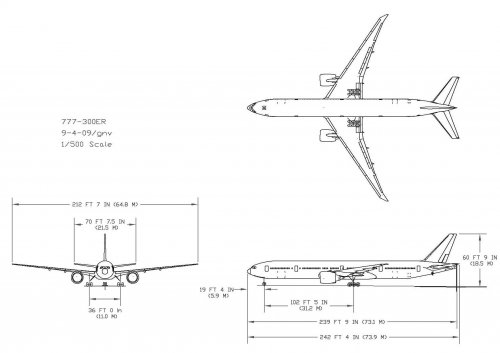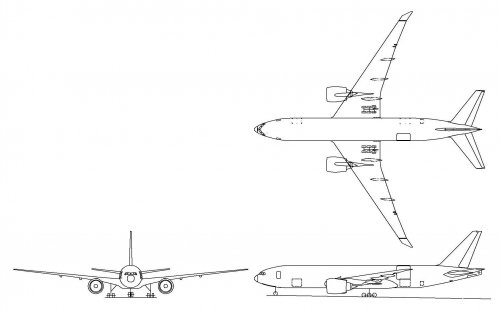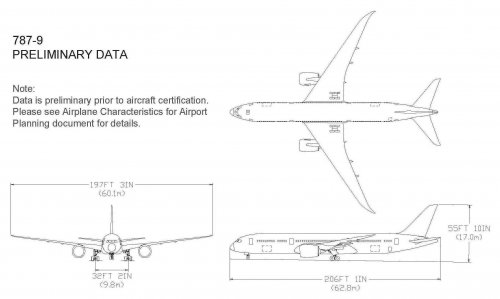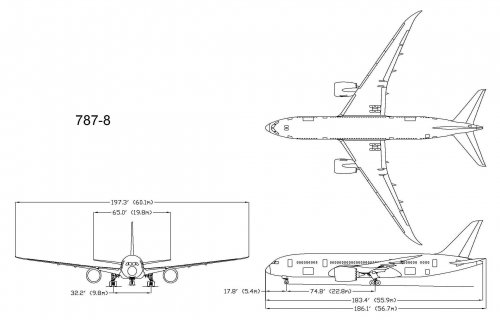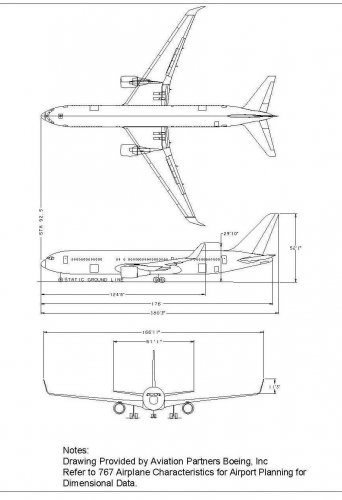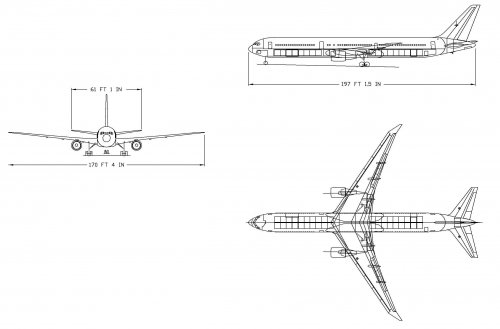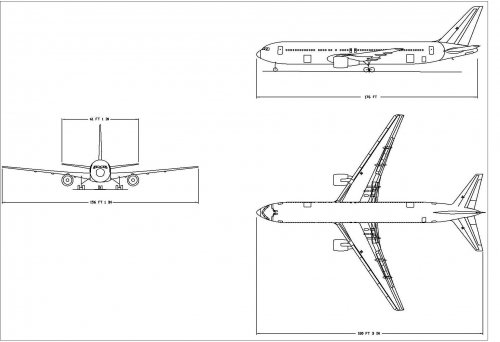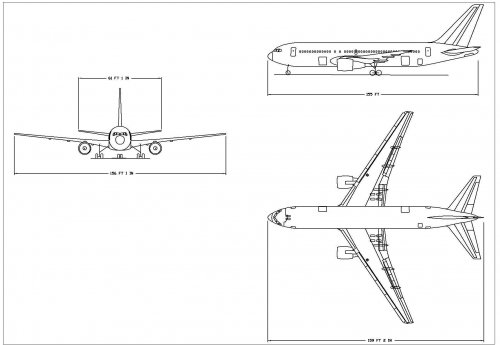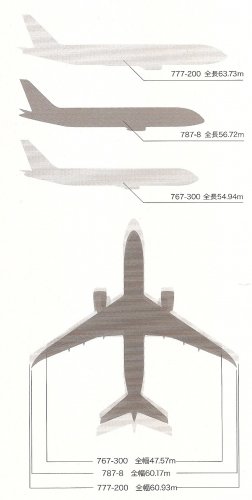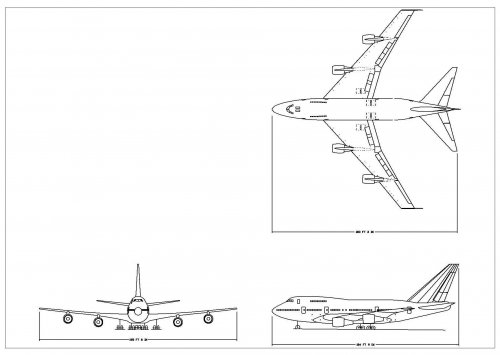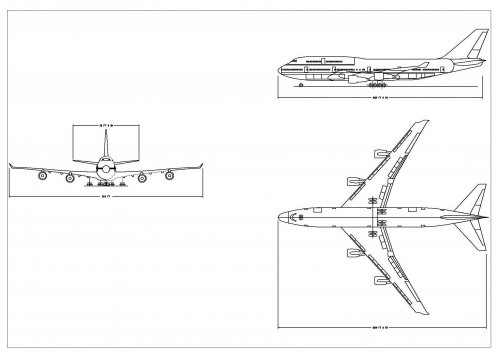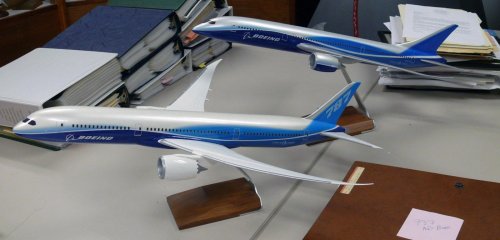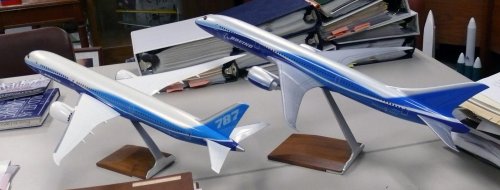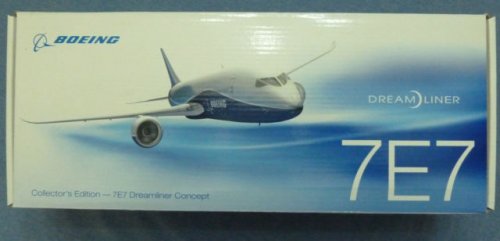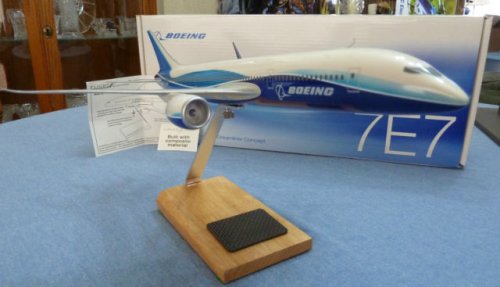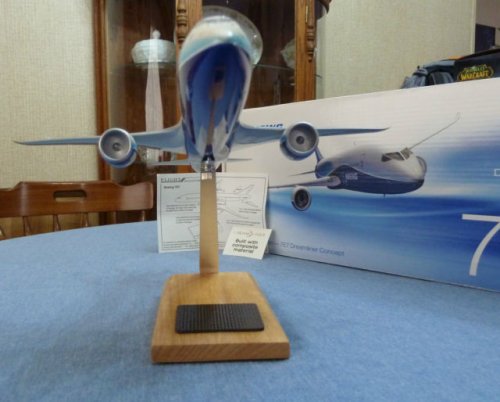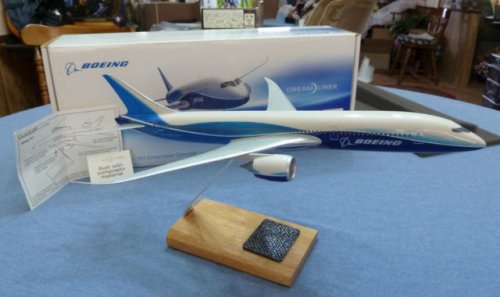You are using an out of date browser. It may not display this or other websites correctly.
You should upgrade or use an alternative browser.
You should upgrade or use an alternative browser.
Boeing 787 Dreamliner
- Thread starter Sundog
- Start date
Matej
Multiuniversal creator
I am not so old so did any other commercial plane in the history have the same amount of problems? It seems to me that A380 problems are in general the same as the B747 had after its introduction, but 787 seems to be really special. I am looking forward how the Airbus will manage its A350 XWB and if it has the same delays.
Edit: I forgot to ask one more general question: should it be a good idea to make some risk-reduction decisions before launching such a groundbreaking program? For example to build some 777 prototype with the full-composite airframe, test it (like X-55), then allocate the smaller share of the subsystems from the current production planes to the foreign suppliers (like to give the contract for the rear fuselage and tails of the 737 to the Japan and test if the deliveries and the quality works) and only then start to attract the customers to launch 787 like program?
Edit: I forgot to ask one more general question: should it be a good idea to make some risk-reduction decisions before launching such a groundbreaking program? For example to build some 777 prototype with the full-composite airframe, test it (like X-55), then allocate the smaller share of the subsystems from the current production planes to the foreign suppliers (like to give the contract for the rear fuselage and tails of the 737 to the Japan and test if the deliveries and the quality works) and only then start to attract the customers to launch 787 like program?
- Joined
- 3 June 2011
- Messages
- 17,299
- Reaction score
- 8,992
Matej said:I am not so old so did any other commercial plane in the history have the same amount of problems? It seems to me that A380 problems are in general the same as the B747 had after its introduction, but 787 seems to be really special. I am looking forward how the Airbus will manage its A350 XWB and if it has the same delays.
Edit: I forgot to ask one more general question: should it be a good idea to make some risk-reduction decisions before launching such a groundbreaking program? For example to build some 777 prototype with the full-composite airframe, test it (like X-55), then allocate the smaller share of the subsystems from the current production planes to the foreign suppliers (like to give the contract for the rear fuselage and tails of the 737 to the Japan and test if the deliveries and the quality works) and only then start to attract the customers to launch 787 like program?
Outsourcing to the lowest bidder is not always a smart move.
- Joined
- 17 October 2006
- Messages
- 2,281
- Reaction score
- 602
http://www.popsci.com/military-aviation-space/article/2004-05/boeing-boeing-gone
A few quotes....
Dreamliner chief engineer Walt Gillette concedes: "It could be the end of us" if the new jetliner does not succeed.
Boeing predicts airlines around the world will buy its midsize 7E7 in vast quantities--up to 3,500 in the next 20 years.
Today Boeing would rather not talk about the [blended wing body] at all. Though the concept is being pursued for military applications, the BWB page has been excised from the company's Web site. A request for an interview with the BWB's creator, Boeing senior technical fellow Robert Liebeck, draws an instant, snippy response: "Our market forecast for the next 20 years does not include commercial applications for the BWB concept. Since our leadership is of one mind on this issue, we don't believe a further interview on this subject is necessary."
There is no reason a composite wing can't be built. Boeing made carbon-fiber composite wings for the 7E7-size B-2 bomber 15 years ago. The question is whether the weight savings are worth the cost (the B-2 was not exactly cheap, even by Pentagon standards). A jetliner's wings carry greater loads than the tail, so the skin must be inches thick, comprising hundreds of plies of fiber. "The challenge isn't building an aircraft but building so many airplanes economically each month, and physically laying down that amount of material," says Bair, adding, "It's not insurmountable."
It had better not be insurmountable, because Boeing has no backup, such as an advanced aluminum structure, in the works. "There's no fallback," says Bair. "We know we can make it work."
A few quotes....
Dreamliner chief engineer Walt Gillette concedes: "It could be the end of us" if the new jetliner does not succeed.
Boeing predicts airlines around the world will buy its midsize 7E7 in vast quantities--up to 3,500 in the next 20 years.
Today Boeing would rather not talk about the [blended wing body] at all. Though the concept is being pursued for military applications, the BWB page has been excised from the company's Web site. A request for an interview with the BWB's creator, Boeing senior technical fellow Robert Liebeck, draws an instant, snippy response: "Our market forecast for the next 20 years does not include commercial applications for the BWB concept. Since our leadership is of one mind on this issue, we don't believe a further interview on this subject is necessary."
There is no reason a composite wing can't be built. Boeing made carbon-fiber composite wings for the 7E7-size B-2 bomber 15 years ago. The question is whether the weight savings are worth the cost (the B-2 was not exactly cheap, even by Pentagon standards). A jetliner's wings carry greater loads than the tail, so the skin must be inches thick, comprising hundreds of plies of fiber. "The challenge isn't building an aircraft but building so many airplanes economically each month, and physically laying down that amount of material," says Bair, adding, "It's not insurmountable."
It had better not be insurmountable, because Boeing has no backup, such as an advanced aluminum structure, in the works. "There's no fallback," says Bair. "We know we can make it work."
Matej
Multiuniversal creator
That's an interesting article. The predictions are always nice:
But I like the previous article posted by flanker the most:
LOL
I have read the interesting analysis (cant find the source at the moment), that after the 787, the A350 XWB will be the last "experiment" of the fast moving all new development, excused by the (planned) lower costs and shorter (planned) development time. If it fails too, all the manufacturers will be forced to return to the old scheme where the development of the new airliner takes at least 10 years.
Boeing intends the Dreamliner to lift off in 2007 and enter service the following year. The assembly line will be located in Everett, where Boeing builds the 777, 767 and 747, but most of the work will be done elsewhere. Specially modified 747s, with bulging upper bodies and side-hinged tails, will bring fully assembled wing and body pieces into Everett from suppliers around the world: The entire wing, for example, will be built in Japan. The assembly line will move at double-quick time. It may take as little as three days to click a 7E7 together.
But I like the previous article posted by flanker the most:
Yet Fancher said the feedback he receives is that employees are "proud to be part of an adventure like this."
LOL
I have read the interesting analysis (cant find the source at the moment), that after the 787, the A350 XWB will be the last "experiment" of the fast moving all new development, excused by the (planned) lower costs and shorter (planned) development time. If it fails too, all the manufacturers will be forced to return to the old scheme where the development of the new airliner takes at least 10 years.
Matej said:That's an interesting article. The predictions are always nice:
LOL
I have read the interesting analysis (cant find the source at the moment), that after the 787, the A350 XWB will be the last "experiment" of the fast moving all new development, excused by the (planned) lower costs and shorter (planned) development time. If it fails too, all the manufacturers will be forced to return to the old scheme where the development of the new airliner takes at least 10 years.
If you could find the source for this it would be much appreciated. Not to go too far off topic, but I am studying systems engineering with a background in aerospace engineering. In the systems engineering world there is a push to apply "Agile" development (which is great for small scale software projects) to all sorts of engineering tasks, something which it doesn't scale too well to. Not that I am qualified to make such a statement, but I think it is hubris. So I find the debacle of the 787 to be very informative, and I might wanto to pass it on to some of my other colleagues.
Matej
Multiuniversal creator
I will take a look tomorrow but wish me some luck - during the christmas holidays I used to read some 200 PDFs PPTs and articles per day, so now I dont have even the clue where to start.
Matej
Multiuniversal creator
Finally at home, so I had a few hours available to take a look, what is new. I found this article and it is almost the mandatory reading for all, who are interesting in the 787 development.
http://seattletimes.nwsource.com/html/sundaybuzz/2014125414_sundaybuzz06.html
http://seattletimes.nwsource.com/html/sundaybuzz/2014125414_sundaybuzz06.html
...
The 787 outsourcing strategy was put place in 2003 by then-Boeing Chairman Harry Stonecipher, who was ousted in 2005, and Commercial Airplanes Chief Alan Mulally, now chief executive at Ford.
"It's easy to look in the rear-view mirror and see things that could have been done differently," Albaugh said. "I wasn't sitting in the room and I don't know what they were facing."
And yet, at least one senior technical engineer within Boeing predicted the outcome of the extensive outsourcing strategy with remarkable foresight a decade ago.
Albaugh and other senior leaders within Boeing may be belatedly paying attention to a paper presented at an internal company symposium in 2001 by John Hart-Smith, a world-renowned airplane structures engineer.
...
In Hart-Smith's analysis, the seeds of Boeing's outsourcing ideas grew out of the McDonnell aircraft business, which focused on military-airplane programs. On the military side of the business, the U.S. government was the major, often the only, customer and it funded development costs in full.
"The military approach didn't require you to risk your own money," Hart-Smith said. "That was the McDonnell Douglas mentality."
He blamed that attitude for the major outsourcing on the MD-95 and proposed MD-12 programs, the failure of which led to the decline of Douglas' commercial-airplane business in California.
The same ideas were transferred to Boeing with the McDonnell Douglas merger and led directly to the 787 outsourcing strategy, he said.
...
Taken to its extreme conclusion, Hart-Smith said mockingly, the strategy of maximizing return on net assets could lead Boeing to outsource everything except a little Boeing decal to slap on the nose of the finished airplane.
Though most of the profits would be outsourced to suppliers along with all the work, and all the company's expertise would wither away, the return on investment in a 25-cent decal could be 5,000 percent.
...
And despite what Hart-Smith has heard on the grapevine, no one from Boeing's leadership has actually called him up to talk about his analysis.
Artist's impression of Pakistan International Airlines Boeing 7E7.
Source:
http://www.historyofpia.com/art10.htm
http://mil.news.sina.com.cn/2005-01-29/1636262676.html
http://www.hydepark.co.il/topic.asp?cat_id=18&topic_id=1065151&whichpage=1&forum_id=4998
http://karmain.altervista.org/boeing_7e7.htm
http://www.nicksarahs.com/
Source:
http://www.historyofpia.com/art10.htm
http://mil.news.sina.com.cn/2005-01-29/1636262676.html
http://www.hydepark.co.il/topic.asp?cat_id=18&topic_id=1065151&whichpage=1&forum_id=4998
http://karmain.altervista.org/boeing_7e7.htm
http://www.nicksarahs.com/
Attachments
blackkite
Don't laugh, don't cry, don't even curse, but.....
- Joined
- 31 May 2007
- Messages
- 8,286
- Reaction score
- 5,840
Hi! Boeing's official drawings.
Attachments
blackkite
Don't laugh, don't cry, don't even curse, but.....
- Joined
- 31 May 2007
- Messages
- 8,286
- Reaction score
- 5,840
- Joined
- 9 October 2009
- Messages
- 19,805
- Reaction score
- 10,297
I think he threw them in for comparison purposes.
Model of Boeing 787 with shark fin tail circa 2003 and model of final design configuration located in the Boeing Archives Bellevue, Washington.
Source:
http://airchive.com/html/museums/boeing-archives-bellevue-washington-usa/boeing-dreamliner-787-and-7e7-models-2003/19155
http://airchive.com/html/museums/boeing-archives-bellevue-washington-usa/boeing-dreamliner-787-and-7e7-models-2003/19156
Source:
http://airchive.com/html/museums/boeing-archives-bellevue-washington-usa/boeing-dreamliner-787-and-7e7-models-2003/19155
http://airchive.com/html/museums/boeing-archives-bellevue-washington-usa/boeing-dreamliner-787-and-7e7-models-2003/19156
Attachments
- Joined
- 9 October 2009
- Messages
- 19,805
- Reaction score
- 10,297
- Joined
- 9 October 2009
- Messages
- 19,805
- Reaction score
- 10,297
787 Making New Routes Economically Viable (Aviation Week & Space Technology)
While routes from Tokyo to destinations such as San Jose and San Diego are not considered “trunk,” they are exactly what Boeing hoped to see happen when its program goals morphed from the Sonic Cruiser to the 7E7 a decade ago. Other newly announced 787 routes falling into the “secondary city” or “long, thin” category include JAL’s nonstops to Boston in April and Helsinki in March 2013. In addition, United Airlines—which will take its first six 787s by year-end—has announced plans to operate between Houston and Auckland, New Zealand.
Overall, Boeing’s network analysis group has forecast the potential for up to 450 new city-pairs that could be created as a result of the 787-8’s particular combination of size, range and operating economics. While the 787 may not open the floodgates on long, thin routes in the same way as did the 767 on shorter transatlantic routes after winning ETOPS clearance more than a quarter of a century ago, these initial 787 service announcements make for interesting conjecture.
Jim Haas, 787 product marketing director, says the plethora of new long-range, thin routes such as Boston-Tokyo, will be a real test of the aircraft and business model. The key, he says, is that the point-to-point services are expected to attract more high-yield passengers.
In addition, “there are 1,200 aircraft in this category, mostly 767s and Airbus A330s,” he says. “This is the only aircraft to replace them, so essentially it has the market to itself.”
Matej
Multiuniversal creator
The only aircraft to replace them? What is he smoking?
Anderman
ACCESS: Secret
- Joined
- 30 September 2006
- Messages
- 241
- Reaction score
- 154
Matej said:The only aircraft to replace them? What is he smoking?
Obviously the pages of his college marketing textbook
Boeing 7E7 Dreamliner Collector's Edition Model found on eBay.
URL:
http://www.ebay.com/itm/Boeing-7E7-Dreamliner-Concept-Collectors-Edition-Executive-Model-RARE-/180903123913?pt=LH_DefaultDomain_0&hash=item2a1eaa9bc9
URL:
http://www.ebay.com/itm/Boeing-7E7-Dreamliner-Concept-Collectors-Edition-Executive-Model-RARE-/180903123913?pt=LH_DefaultDomain_0&hash=item2a1eaa9bc9
Attachments
- Joined
- 9 October 2009
- Messages
- 19,805
- Reaction score
- 10,297
Boeing's Billion Dollar Dilemma (Aviation Week)
If the Jan. 7 fire on a Japan Airlines (JAL) Boeing 787 at Boston Logan International Airport proved anything to Boeing it was that no amount of exhaustive pre-service testing can guard against the unexpected.
It also showed that the 787 remains under greater scrutiny than any other aircraft. Even with deliveries well under way and the aircraft performing better than specification, the whole company still catches a cold when the program so much as sneezes. Yet even Boeing, seasoned as it is to hard knocks over the 787’s troubled development, seems to have been shaken by the reaction to the latest problem. The smoke had barely cleared before Boeing’s stock began a slide that within hours wiped $2.6 billion from the company’s value.
The event centered on a lithium ion battery unit, located in the aft electrical/electronics (E/E) bay, which is designed to start the auxiliary power unit (APU) and provide back-up lighting power. The JAL 787, which was delivered to the airline on Dec. 20, had been on the ground for about 25 min. when smoke was detected in the cabin. Airport firefighters responded and, according to the National Transportation Safety Board which is investigating the event, “detected a fire in the electronics and equipment bay near the APU battery box. The fire was extinguished about 40 minutes after arrival of the first rescue and fire personnel.”
The fire caused a furor not only because it was the latest in a series of electrical system-related issues to dog the 787 in recent weeks, but also because it concerned the lithium ion battery, the use of which was flagged by the FAA in 2007 as a special condition for certification. Earlier issues included problems in a power distribution panel that forced the diversion of a United Airlines 787 to New Orleans on Dec. 4, as well as similar electrical system-related issues later reported by Qatar Airways and LAN Airlines.
However for all the attention given to these and other early in-service problems, such as leaks in the fuel system addressed by a recent FAA airworthiness directive, Boeing maintains that the 50-strong 787 fleet is performing to a similar reliability level as the Boeing 777 was at this early stage in its service life. It also says the 787’s dispatch reliability rates are better than for some other early Boeing model fleets. The company also says the number of electrical system-related issues appears to be worse than it is simply because the 787 has a disproportionately higher number of electrical systems than other models.
- Joined
- 9 October 2009
- Messages
- 19,805
- Reaction score
- 10,297
http://www.telegraph.co.uk/finance/newsbysector/transport/9804868/Japanese-airlines-ground-Boeing-787-Dreamliner-fleet-after-emergency-landing.html
http://www.reuters.com/article/2013/01/16/us-boeing-ana-idUSBRE90F01820130116
pic:
http://s1.reutersmedia.net/resources/r/?m=02&d=20130116&t=2&i=694613998&w=&fh=&fw=&ll=700&pl=300&r=CBRE90F098T00
Apparent lithium ion battery fire.
pic:
http://s1.reutersmedia.net/resources/r/?m=02&d=20130116&t=2&i=694613998&w=&fh=&fw=&ll=700&pl=300&r=CBRE90F098T00
Apparent lithium ion battery fire.
2IDSGT
Ah tale yew wut!
- Joined
- 27 November 2012
- Messages
- 365
- Reaction score
- 11
Al Jazeera seems to have taken a keen interest. Three stories in recent days.
http://www.aljazeera.com/news/asia-pacific/2013/01/20131161112528514.html
http://www.aljazeera.com/news/americas/2013/01/20131111515271301.html
http://www.aljazeera.com/video/americas/2013/01/20131911749805807.html
http://www.aljazeera.com/news/asia-pacific/2013/01/20131161112528514.html
http://www.aljazeera.com/news/americas/2013/01/20131111515271301.html
http://www.aljazeera.com/video/americas/2013/01/20131911749805807.html
- Joined
- 25 June 2009
- Messages
- 13,745
- Reaction score
- 2,928
SEVEN failures in two weeks? That's not bad, that's terrible. Especially for an aircraft with such a conservative design, and one that was already delayed by three or four years in its development phase... 
Compare this to the near flawless record of the highly innovative and groundbreaking Airbus A380, and that's more than a facepalm for Boeing... it's like Dr. T's 1000 hands doing a facepalm at once! ;D
Compare this to the near flawless record of the highly innovative and groundbreaking Airbus A380, and that's more than a facepalm for Boeing... it's like Dr. T's 1000 hands doing a facepalm at once! ;D
Bill Walker
Per Ardua ad Nauseum
Stargazer2006 said:Compare this to the near flawless record of the highly innovative and groundbreaking Airbus A380,
You're joking, right?
Stargazer2006 said:SEVEN failures in two weeks? That's not bad, that's terrible. Especially for an aircraft with such a conservative design, and one that was already delayed by three or four years in its development phase...
Compare this to the near flawless record of the highly innovative and groundbreaking Airbus A380, and that's more than a facepalm for Boeing... it's like Dr. T's 1000 hands doing a facepalm at once! ;D
You do recall a380 being originally designed in such a way that wiring won't fit, so empty airframes had to sit idle, with Arbus paying literally billions in late fees, while the wiring was redesigned, right? How about another a380 losing half of an engine while in flight not long ago?
blackkite
Don't laugh, don't cry, don't even curse, but.....
- Joined
- 31 May 2007
- Messages
- 8,286
- Reaction score
- 5,840
Shocked! Battery trouble occured just after take off. Cabin filled with light smoke. Returned to airport for emergency landing.
Prior to this accident, fuel leak in Boston, windshield broke in Japan, etc.
http://www.youtube.com/watch?v=tdewfAfOO58
Prior to this accident, fuel leak in Boston, windshield broke in Japan, etc.
http://www.youtube.com/watch?v=tdewfAfOO58
blackkite
Don't laugh, don't cry, don't even curse, but.....
- Joined
- 31 May 2007
- Messages
- 8,286
- Reaction score
- 5,840
Hi next one. Battery!!
http://www3.nhk.or.jp/daily/english/20130117_22.html
http://www3.nhk.or.jp/daily/english/20130117_22.html
- Joined
- 25 June 2009
- Messages
- 13,745
- Reaction score
- 2,928
I was serious about Boeing being too conservative and Airbus being highly innovative, but perhaps overly enthusiastic about its "near flawless record"... :-\
True, the A380 had its share of early troubles, but keep in mind that it's a totally new kind of aircraft, and given that parameter, I think it has fared much better so far than the 787, which presents no real aerodynamic or logistic challenge. And since the A380 troubles were addressed, it has proved quite satisfactory, hasn't it? And at any rate, it never had 7 serious incidents in two weeks!
True, the A380 had its share of early troubles, but keep in mind that it's a totally new kind of aircraft, and given that parameter, I think it has fared much better so far than the 787, which presents no real aerodynamic or logistic challenge. And since the A380 troubles were addressed, it has proved quite satisfactory, hasn't it? And at any rate, it never had 7 serious incidents in two weeks!
SlowMan
I really should change my personal text
- Joined
- 9 September 2012
- Messages
- 154
- Reaction score
- 5
blackkite said:Hi next one. Battery!!
http://www3.nhk.or.jp/daily/english/20130117_22.html
The fires are caused by the lithium ion battery supplied by GS Yuasa, a Japanese battery maker.
Lithium Ion batteries specialized by Japanese are inherently less stable but cheaper than Lithium Polymer batteries specialized by Koreans, this is why most US and European brand EVs use Korean Lithium Polymer batteries while Japanese automakers stick with local batteries by local suppliers.
Just replace the GS Yuasa's battery with a Lithium Polymer battery and the problem will be gone.
a picture of the affected battery can be found here:
http://avherald.com/h?article=45c377c5&opt=512
According to an article at greencarcongress the affected batteries are this type:
http://www.s399157097.onlinehome.us/SpecSheets/LVP10-65.pdf
http://avherald.com/h?article=45c377c5&opt=512
According to an article at greencarcongress the affected batteries are this type:
http://www.s399157097.onlinehome.us/SpecSheets/LVP10-65.pdf
Dragon029
ACCESS: Top Secret
- Joined
- 17 March 2009
- Messages
- 882
- Reaction score
- 430
SlowMan said:blackkite said:Hi next one. Battery!!
http://www3.nhk.or.jp/daily/english/20130117_22.html
The fires are caused by the lithium ion battery supplied by GS Yuasa, a Japanese battery maker.
Lithium Ion batteries specialized by Japanese are inherently less stable but cheaper than Lithium Polymer batteries specialized by Koreans, this is why most US and European brand EVs use Korean Lithium Polymer batteries while Japanese automakers stick with local batteries by local suppliers.
Just replace the GS Yuasa's battery with a Lithium Polymer battery and the problem will be gone.
Apparently GS Yuasa sources their cells from China anyway; I wouldn't be surprised if the Koreans do to.
Also, best to stay with non-polymer Lithium Ion batteries; Li-Ions can be dangerous, popping, emitting smoke, combusting, etc, but LiPo batteries in particular are far more eager to explode into flames.
- Joined
- 9 October 2009
- Messages
- 19,805
- Reaction score
- 10,297
SlowMan
I really should change my personal text
- Joined
- 9 September 2012
- Messages
- 154
- Reaction score
- 5
There is no non-Korean lithium polymer battery maker. This is a closely guarded secret as it came from the Korean government lab and the Korean battery companies that received the tech from the government signed a non-disclosure agreement, so only Korean vendors can mass-manufacture this type of battery.Dragon029 said:Apparently GS Yuasa sources their cells from China anyway; I wouldn't be surprised if the Koreans do to.
There was an ongoing lawsuit between LG and A123 over A123's recruitment of LG battery engineers so that A123 too could develop its own lithium polymer batter, before A123 went bankrupt.
The safety of Lithium Ion vs Lithium Polymer has been well documented in the automotive world where there is an intensive effort to build EVs worldwide. Lithium Polymer types are far more stable and durable than Lithium Ion types.but LiPo batteries in particular are far more eager to burst into explode into flames.
2IDSGT
Ah tale yew wut!
- Joined
- 27 November 2012
- Messages
- 365
- Reaction score
- 11
http://www.flightglobal.com/news/articles/elon-musk-boeing-787-battery-fundamentally-unsafe-381627/Elon Musk: Boeing 787 battery fundamentally unsafe
...Both Boeing and Tesla use batteries fueled by lithium cobalt oxide, which is among the most energy-dense and flammable chemistries of lithium-ion batteries on the market. While Boeing elected to use a battery with a grouping of eight large cells, Tesla's batteries contain thousands of smaller cells that are independently separated to prevent fire in a single cell from harming the surrounding ones.
"Moreover, when thermal runaway occurs with a big cell, a proportionately larger amount of energy is released and it is very difficult to prevent that energy from then heating up the neighboring cells and causing a domino effect that results in the entire pack catching fire," says Musk.
An aerospace-capable version of Tesla's battery has been developed for use in SpaceX's Falcon 9 space launch vehicle. SpaceX, also owned by Musk, competes with Boeing/Lockheed Martin joint venture United Launch Alliance for customers. Boeing has thus far declined offers of assistance from Tesla and SpaceX, says Musk...
2IDSGT
Ah tale yew wut!
- Joined
- 27 November 2012
- Messages
- 365
- Reaction score
- 11
More news.
http://www.wired.com/autopia/2013/01/boeing-787-battery-design-musk/
http://www.wired.com/autopia/2013/01/boeing-787-battery-design-musk/
With the myriad of options available to 787 customers (everything from engines to interior lighting), I'm simply god-smacked that there is no alternative for something as modular as a battery. The bays in which the things are installed appear to provide some flexibility with regard to physical size and shape (to my untrained eye anyways).Boeing Batteries Draw Criticism As Dreamliner Probe Continues
...The relatively simple looking design of the Boeing battery, manufactured by the Japanese firm GS Yuasa, immediately caught the attention of lithium-ion battery expert Dr. K.M. Abraham. Abraham has been researching and producing lithium-ion batteries since 1976 and says proper design is critical for both power output and safety.
“It did not look like a sophisticated battery pack to me” Abraham said of his first impression after seeing a photo of a Dreamliner battery. The 32-volt Boeing battery uses eight 3.7 volt cells housed in a single metal container.
The manufacturing process is also a major concern, according to Abraham. The 18650 cells used by Tesla and others experienced quality control problems early on, and it was more than a decade before the design and manufacturing was refined. These days, failure rates are extremely low — less than one in a million, said Abraham. He agrees the design used by Tesla reduces the chance of a thermal runaway resulting in a larger event.
“They use a smaller cell approach, but I think it is a much safer way of doing that,” he said of Tesla. “They use a modular construction. Once a cell goes, it is isolated, there is no large runaway...”
I guess the battery-problem is caused by the lack of sufficient thermal conduction. On earlier airlines the fuselage skin was made of aluminum, a perfect conductor. Now it is carbon-fibre, it conducts way less, like all plastics do.
Any comments?
Any comments?
Bill Walker
Per Ardua ad Nauseum
People have been making composite airframes, with batteries, for over 40 years. Most large battery installations, even in metal aircraft, require some supplemental cooling. Demonstration of effective battery cooling under adverse battery operating conditions is a fundamental certification test. If Boeing screwed up battery cooling, they have huge systemic problems in their design and test organizations. If the FAA didn't catch this, we have big problems ahead.
I suspect the real culprit is some unknown battery operating mode that generates far more heat than anybody expected. This would be a problem even in a metal airframe.
I suspect the real culprit is some unknown battery operating mode that generates far more heat than anybody expected. This would be a problem even in a metal airframe.

